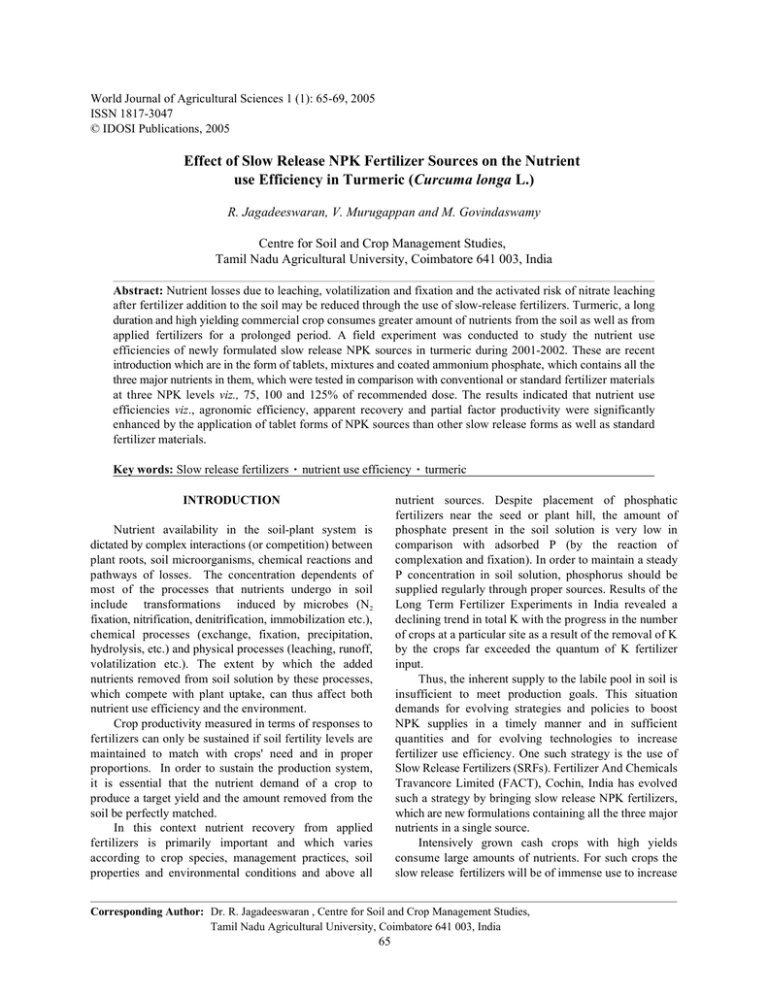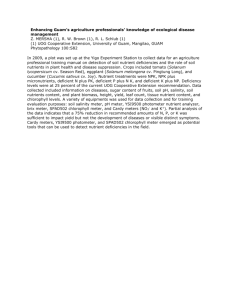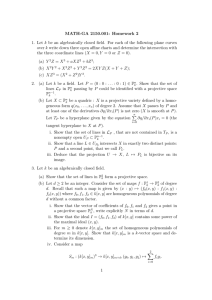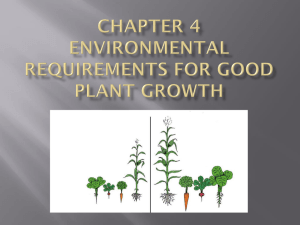Effect of Slow Release NPK Fertilizer Sources on the Nutrient
advertisement

World Journal of Agricultural Sciences 1 (1): 65-69, 2005 ISSN 1817-3047 © IDOSI Publications, 2005 Effect of Slow Release NPK Fertilizer Sources on the Nutrient use Efficiency in Turmeric (Curcuma longa L.) R. Jagadeeswaran, V. Murugappan and M. Govindaswamy Centre for Soil and Crop Management Studies, Tamil Nadu Agricultural University, Coimbatore 641 003, India Abstract: Nutrient losses due to leaching, volatilization and fixation and the activated risk of nitrate leaching after fertilizer addition to the soil may be reduced through the use of slow-release fertilizers. Turmeric, a long duration and high yielding commercial crop consumes greater amount of nutrients from the soil as well as from applied fertilizers for a prolonged period. A field experiment was conducted to study the nutrient use efficiencies of newly formulated slow release NPK sources in turmeric during 2001-2002. These are recent introduction which are in the form of tablets, mixtures and coated ammonium phosphate, which contains all the three major nutrients in them, which were tested in comparison with conventional or standard fertilizer materials at three NPK levels viz., 75, 100 and 125% of recommended dose. The results indicated that nutrient use efficiencies viz., agronomic efficiency, apparent recovery and partial factor productivity were significantly enhanced by the application of tablet forms of NPK sources than other slow release forms as well as standard fertilizer materials. Key words: Slow release fertilizers nutrient use efficiency INTRODUCTION turmeric nutrient sources. Despite placement of phosphatic fertilizers near the seed or plant hill, the amount of phosphate present in the soil solution is very low in comparison with adsorbed P (by the reaction of complexation and fixation). In order to maintain a steady P concentration in soil solution, phosphorus should be supplied regularly through proper sources. Results of the Long Term Fertilizer Experiments in India revealed a declining trend in total K with the progress in the number of crops at a particular site as a result of the removal of K by the crops far exceeded the quantum of K fertilizer input. Thus, the inherent supply to the labile pool in soil is insufficient to meet production goals. This situation demands for evolving strategies and policies to boost NPK supplies in a timely manner and in sufficient quantities and for evolving technologies to increase fertilizer use efficiency. One such strategy is the use of Slow Release Fertilizers (SRFs). Fertilizer And Chemicals Travancore Limited (FACT), Cochin, India has evolved such a strategy by bringing slow release NPK fertilizers, which are new formulations containing all the three major nutrients in a single source. Intensively grown cash crops with high yields consume large amounts of nutrients. For such crops the slow release fertilizers will be of immense use to increase Nutrient availability in the soil-plant system is dictated by complex interactions (or competition) between plant roots, soil microorganisms, chemical reactions and pathways of losses. The concentration dependents of most of the processes that nutrients undergo in soil include transformations induced by microbes (N2 fixation, nitrification, denitrification, immobilization etc.), chemical processes (exchange, fixation, precipitation, hydrolysis, etc.) and physical processes (leaching, runoff, volatilization etc.). The extent by which the added nutrients removed from soil solution by these processes, which compete with plant uptake, can thus affect both nutrient use efficiency and the environment. Crop productivity measured in terms of responses to fertilizers can only be sustained if soil fertility levels are maintained to match with crops' need and in proper proportions. In order to sustain the production system, it is essential that the nutrient demand of a crop to produce a target yield and the amount removed from the soil be perfectly matched. In this context nutrient recovery from applied fertilizers is primarily important and which varies according to crop species, management practices, soil properties and environmental conditions and above all Corresponding Author: Dr. R. Jagadeeswaran , Centre for Soil and Crop Management Studies, Tamil Nadu Agricultural University, Coimbatore 641 003, India 65 World J. Agric. Sci., 1 (1): 65-69, 2005 Table 1: Composition of slow release NPK sources Formulation Composition Tablet 1 Urea formaldehyde, ammonium sulphate, amophos, rock phosphate, muriate of potash and clay (pelletized) Tablet 2 Phosphogypsum-urea, ammonium sulphate, amophos, rock phosphate, muriate of potash, clay and gypsum (pelletized) Mixture 1 Mixture of contents of tablet 2 Mixture 2 Mixture of contents of tablet 2 + neem cake Coated FAP Coated amophos, urea and muriate of potash (mixture) nutrient use efficiency. Turmeric being a long duration and high yielding crop, it consumes greater amount of nutrients from the soil as well as from applied fertilizers for a prolonged period. In India it occupies about 1.6 lakh ha with a production of 6.54 lakh tones and sharing 15.06% of total spices export. Though, turmeric being a high value commercial crop its nutrient exploiting property and applied nutrient efficiency were not studied in detail so for. These slow release fertilizers were applied to their respective plots in two splits, one at 30th Day after Sowing (DAS) and another at 120th DAS. Two numbers of tablets were placed near the root zone of turmeric crop by making small holes. The mixtures and coated FAP were applied as that of standard fertilizers near the hill of the turmeric crop on the surface by placement method. The recommended dose of standard fertilizers was applied as urea, single super phosphate and muriate of potash. Single super phosphate was applied in a single dose basally on 30th DAS and urea and muriate of potash were applied in five equal splits at monthly interval starting from 30th day after sowing. All other routine cultural operations until the harvest of the crop were followed as per the recommendations made in the Crop Production Technologies of Horticultural Crops [1]. At maturity the dried above ground portion (shoot) was removed 10 days before harvest leaving below ground rhizomes so as to allow the rhizome to mature. The rhizomes were harvested by digging and the fresh rhizome yield was recorded. MATERIALS AND METHODS A field experiment was conducted in a farmer’s field in Coimbatore district of South India on a sandy clay loam soil (fine mixed calcareous isohyperthermic Udic Haplustalf) during June 2001 to March 2002 with turmeric (cv. Erode local) as test crop. Representative sample of surface soil (0-15 cm depth) collected from the experimental field before the start of the experiment was analyzed. The pH of the soil was 8.20 and electrical conductivity (EC) was 0.32 dS m 1 (1:2.5, soil water suspension). Organic carbon content was 0.963%, KMnO4-N was 235 kg ha 1, Olsen-P was 24.2 kg ha 1 and NH4OAc-K was 384 kg ha 1. There are five Slow Release (SR) NPK sources viz., tablet 1, tablet 2, mixture 1, mixture 2 and coated FACT Ammonium Phosphate (FAP), which were tested for their efficacy in the present study. The compositions of these materials are given in Table 1. These five SR NPK sources were tested in comparison with conventional (or) standard NPK fertilizers viz., urea, single super phosphate and muriate of potash. These six fertilizer sources were applied at three NPK levels viz., 75, 100 and 125% of recommended dose (150:60:108 kg N, P2O5 and K2O, respectively). Thus, there were totally eighteen treatments (six NPK sources each at three levels), which were replicated three times in a Randomized Block Design. The experimental field was ploughed, leveled and divided into 54 plots of each 20 m2 (5 x 4 m) size. Sowing of well matured, disease free turmeric rhizome (cv. Erode local, 10 months duration) was done by following a spacing of 45 cm between the row and 15 cm within the row. The required quantity of N, P2O5 and K 2O as per the levels viz., 75, 100 and 125% of recommended dose for each plant was satisfied with 4 tablets (in the case of tablets) and its equivalent quantity in the case of mixtures. Nutrient use efficiency: The nutrient use efficiencies viz., agronomic efficiency (response ratio) and apparent nutrient recovery were calculated as follows; Agronomic Efficiency (AE): 1 AE = 1 Yield in fertilized plot (kg ha¯ ) - Yield in control plot (kg ha¯ ) Quantity of fertilizer nutrient applied (kg ha¯1) Apparent Nutrient Recovery (ANR): ANR = Uptake in fertilized plot (kg ha¯1) 1 Uptake in control plot (kg ha¯ ) Quantity of fertilizer nutrient applied (kg ha¯ 1) Partial factor productivity (Pfp): The partial factor productivity (Pfp) from applied nutrients is a useful measure of nutrient use efficiency because it provides an integrative index that quantifies total economic output relative to utilization of all nutrient resources in the system [2]. It is the ratio of yield to applied nutrients and stated as : Pfp = Y/Nr Where, Y is the yield of dry rhizome in kg ha 1 and Nr is the amount of fertilizer nutrients (N+P2O5+K2O) in kg ha 1. 66 World J. Agric. Sci., 1 (1): 65-69, 2005 Table 2: Nitrogen use efficiency in turmeric with different NPK sources NPK sources (S) ------------------------------------------------------------------------------------------------------------------------------------------------------------------Levels (L) Tablet 1 Tablet 2 Mixture 1 Mixture 2 Coated FAP Standard fertilizer Mean Agronomic efficiency (kg dry rhizome / kg N applied) ------------------------------------------------------------------------------------------------------------------------------------------------------------------75% NPK 25.3 27.0 18.8 20.1 20.5 20.1 22.0 100% NPK 27.3 29.2 21.6 22.0 21.0 23.0 24.0 125% NPK 24.0 25.7 20.7 20.2 20.5 20.2 21.9 Mean 25.5 27.3 20.3 20.8 20.6 21.1 22.6 L S L×S SE (d) 0.9 1.3 2.2 CD (p = 0.05) 1.9 2.6 NS Apparent recovery (%) ------------------------------------------------------------------------------------------------------------------------------------------------------------------75% NPK 36.0 37.2 19.9 26.9 22.9 28.6 28.6 100% NPK 36.7 37.0 23.0 35.1 35.3 20.6 31.3 125% NPK 36.5 38.3 25.8 27.0 24.7 21.8 29.0 Mean 36.4 37.5 22.9 29.7 27.6 23.7 29.6 L S L×S SE (d) 1.0 1.3 2.2 CD (p = 0.05) 1.9 2.6 4.5 Table 3: Phosphorus use efficiency in turmeric with different NPK sources NPK sources (S) ------------------------------------------------------------------------------------------------------------------------------------------------------------------Levels (L) Tablet 1 Tablet 2 Mixture 1 Mixture 2 Coated FAP Standard fertilizer Mean Agronomic efficiency (kg dry rhizome / kg P2O5 applied) ------------------------------------------------------------------------------------------------------------------------------------------------------------------75% NPK 63.5 67.9 47.1 50.4 51.5 50.4 55.1 100% NPK 68.2 73.1 53.9 55.0 52.4 57.6 60.0 125% NPK 60.1 64.5 51.9 50.6 51.3 50.6 54.8 Mean 64.0 68.5 51.0 52.0 51.7 52.9 56.7 L S L×S SE (d) 2.3 3.2 5.6 CD (p = 0.05) 4.6 6.5 NS Apparent recovery (%) ------------------------------------------------------------------------------------------------------------------------------------------------------------------75% NPK 19.1 21.6 12.8 16.2 13.6 16.5 16.6 100% NPK 23.1 23.9 14.5 14.9 17.7 19.7 19.0 125% NPK 21.9 22.1 15.8 17.7 17.0 16.7 18.5 Mean 21.4 22.5 14.4 16.3 16.1 17.7 18.0 L S L×S SE (d) 0.6 0.9 1.6 CD (p = 0.05) 1.3 1.8 NS RESULTS sources. Mixture 2 and coated FAP recorded significantly higher recovery percentage over mixture 1 and standard fertilizer. Nitrogen use efficiency: Agronomic efficiency due to nitrogen (N) fertilization calculated as kg dry rhizome per kg of N applied are presented in Table 2. Agronomic efficiency varied from 18.8 kg dry rhizome per kg of N applied with mixture 1 at 75% NPK level to 29.2 kg dry rhizome per kg of N applied with tablet 2 at 100% NPK level. The agronomic efficiency was maximum with 100% NPK level with all NPK sources and with tablet 2 at all levels of NPK. Agronomic efficiency with tablet 2 was on par with tablet 1 and significantly superior to other NPK sources. Apparent N recovery in turmeric varied from 19.9% with mixture 1 at 75% NPK level to 38.3% with tablet 2 at 125% NPK level. The recovery percentage was maximum with tablet 2 at all levels of NPK. However, tablet 2 was on par with tablet 1 and significantly superior to other NPK Phosphorus use efficiency: Agronomic efficiency due to phosphorus (P) fertilization calculated as kg dry rhizome per kg of P2O5 applied are presented in Table 3. The results indicated that the efficiency was high with 100% NPK level irrespective of NPK sources. Agronomic efficiency varied from 47.1 kg dry rhizome per kg of P2O5 applied with mixture 1 at 75% NPK level to 73.1 kg dry rhizome per kg of P2O5 applied with tablet 2 at 100% NPK level. In its effect on agronomic efficiency, Tablet 2 was on par with tablet 1 and both of them were significantly superior to other NPK sources. Apparent P recovery in was highest (23.9%) with tablet 2 at 100% NPK level. and the lowest P recovery (12.8%) was with mixture 1 at 75% NPK level. The 67 World J. Agric. Sci., 1 (1): 65-69, 2005 Table 4: Potassium use efficiency in turmeric with different NPK sources NPK sources (S) ------------------------------------------------------------------------------------------------------------------------------------------------------------------Levels (L) Tablet 1 Tablet 2 Mixture 1 Mixture 2 Coated FAP Standard fertilizer Mean Agronomic efficiency (kg dry rhizome / kg K2O applied) ------------------------------------------------------------------------------------------------------------------------------------------------------------------75% NPK 35.3 37.7 26.2 28.0 28.6 28.0 30.6 100% NPK 37.9 40.6 30.0 30.6 29.1 32.0 33.4 125% NPK 33.4 35.8 28.8 28.1 28.5 28.1 30.5 Mean 35.5 38.1 28.3 28.9 28.7 29.4 31.5 L S L×S SE (d) 1.3 1.8 3.1 CD (p = 0.05) 2.6 3.6 NS Apparent recovery (%) -------------------------------------------------------------------------------------------------------------------------------------------------------------------75% NPK 106 104 69 95 84 85 90 100% NPK 107 131 87 76 92 93 98 125% NPK 118 121 97 90 104 93 104 Mean 110 118 84 87 94 90 97 L S L×S SE (d) 2.9 4.1 7.1 CD (p = 0.05) 5.9 8.4 14.5 Table 5: Partial factor productivity (Pfp) in turmeric with different NPK sources NPK sources (S) -------------------------------------------------------------------------------------------------------------------------------------------------------------Levels (L) Tablet 1 Tablet 2 Mixture 1 Mixture 2 Coated FAP Standard fertilizer (kg dry rhizome / kg N+P2O5+K2O applied) -------------------------------------------------------------------------------------------------------------------------------------------------------------75% NPK 27.5 28.3 24.4 25.0 25.2 25.0 100% NPK 24.5 25.4 21.8 22.0 21.5 22.5 125% NPK 20.6 21.5 19.1 18.8 19.0 18.8 DISCUSSION recovery was maximum with tablet 2 at all levels of NPK and on par with tablet 1, however, mixture 2, coated FAP and standard fertilizer were equally effective in influencing P recovery in turmeric. The sources of N influenced the agronomic efficiency and apparent recovery with respect to nitrogen. Tablet 2 and 1 have recorded, respectively, 27 and 26 kg dry rhizome per kg of N which are about 5 to 8 kg increase in dry rhizome per kg of N applied. Thus, in the present study, the superiority of tablet form of NPK was clearly established over other SR NPK sources. Achievement of 38 to 40% of apparent N recovery was very significant in the context of the conclusions from the recent review on nutrient use efficiency that N use efficiency in cereals for the developing nation was 29%. They have calculated that the present fertilizer use scale, a 1% increase in N use efficiency for cereal production worldwide would lead to a $ 235 million saving in cost of N fertilizer. In the case of P use efficiency also, similar trend as the one observed as that of nitrogen. An increase of about 14 to 25 kg dry rhizome per kg of P2O5 was recorded with tablet 2 over the standard fertilizers. Agronomic efficiency and apparent recovery with respect to K were higher with tablet form of slow release fertilizers. An increase of 9 to 15 kg dry rhizome per kg of K 2O was recorded with tablet 2 over that of standard fertilizers. Also, an increase of 28 to 48% in K recovery was recorded with tablet 2 over standard fertilizers. Potassium use efficiency: Agronomic efficiency calculated as kg dry rhizome per kg K2O applied varied from 26.2 kg with mixture 1 at 75% NPK level to 40.6 kg with tablet 2 at 100% NPK level (Table 4). Tablet 2 was on par with tablet 1 and significantly superior to other NPK sources. Apparent K recovery was highest (131%) with tablet 2 at 100% NPK level and lowest (69%) with mixture 1 at 75% NPK level. K recovery with tablet 1 and 2 were on par and significantly superior to other NPK sources. Maximum recovery was exhibited with tablet 2 at all levels of NPK. Mixture 1 was on par with mixture 2 and standard fertilizer. Partial factor productivity: Data on partial factor productivity in turmeric as calculated by kg dry rhizome per kg of N+P2O5+K2O applied are presented in Table 5. The partial productivity decline with increasing levels of NPK. The highest value was observed with tablet 2 (28.3 kg), which was followed by tablet 1 (27.5 kg). Other SR NPK sources recorded more or less similar values as that of straight fertilizer. 68 World J. Agric. Sci., 1 (1): 65-69, 2005 ACKNOWLEDGEMENT The tablet form of SR NPK fertilizers were applied by placement at a depth of 5 cm near the rhizosphere. Slow release of nitrogen coupled with reduced losses due to NH3 volatilization and leaching have evidently enhanced nitrogen uptake from the tablets. Whereas in the case of mixtures and standard fertilizer, nitrogen uptake was of low magnitude because of increased losses of nitrogen through NH3 volatilization and leaching due to contact of these sources on their application with larger volume soil as compared to the tablets. Placement of phosphorus fertilizers near the rhizosphere soil ensured a higher concentration of P in unit volume of soil solution in the immediate vicinity of turmeric roots. Similar beneficial effects of P placement were discussed by Prummel [3], Reith [4] and Ryan [5]. Potassium (muriate of potash) is normally applied by broadcast and very rarely by banded application in soils of low K availability or with high K fixing capacity. Welch et al. [6] have found as much as four times increase in crop response to banded application over broadcast application of K. Thus, the slow and steady release of nutrients from tablets near the rhizosphere matched the crop uptake sparing not as much nutrients for fixation by soil clays or for losses as from other SR NPK sources resulting in enhanced K uptake from the tablets by turmeric. In the case of mixtures, coated FAP and standard fertilizers, the volume of the experimental soil, with which these fertilizer materials were in contact on application was large, evidently nutrient reversion reactions have occurred at a faster rate resulting in the fixation of applied nutrients in amounts of higher magnitude as compared to those from tablet form of SR NPK sources. The authors gratefully acknowledge the Fertilizers and Chemicals Travancore Limited, Cochin, India for their financial assistance to carryout this study. REFERENCES 1. 2. 3. 4. 5. 6. 69 Anonymous, 1999. Crop Production Technologies of Horticultural Crops. Department of Horticulture and Plantation Crops, Government of Tamil Nadu, Chennai, India. Cassman, K.G., G.C. Gines, M.A. Dizon, M.I. Samson and J.M. Alcantara, 1996. Nitrogen use efficiency in tropical low land rice systems: Contributions from indigenous and applied nitrogen. Field Crop Res., 47: 1-12. Prummel, J., 1957. Fertilizer placement experiments. Plant Soil, 8: 231-253. Reith, J.W.S., 1959. Fertilizer placement for swedes and turnips. Emp. J. Exp. Agric., 27: 300-312. Ryan, P.F., 1962. Fertilizer placement for kale. Irish J. Agric. Res., 1:231-236. Welch, L.F., P.E. Johnson, G.E. McKibben, L.V. Boone and I.W. Pendleton, 1966. Relative efficiency of broadcast versus banded potassium for corn. Agron. J., 58: 618-621.




